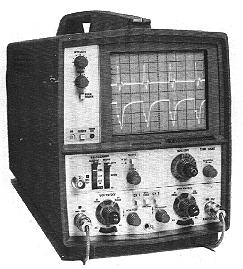 |
 |
| Below is a picture of my trusty oscilloscope from Tektronics . It's an oldy but it works. |
| Welcome to my Oscilloscope notes and diagrams |
| To the beginner an oscilloscope looks like a formidable piece of electronics equipment. Well on outset it is, but with a little hands on experience and knowledge the basic controls can be mastered in a relatively short time. |
| Understanding and manipulating what is being displayed on the oscilloscope screen is what really seperates a novice from a professional. |
| My old workhorse oscilloscope (Tek922) |
| Basically an oscilloscope display screen presents a graph of amplitude verses time for a given waveform. The screen is divided up into an 8 by 10 grid called a graticule that defines the X and Y coordinates of the graph. |
| The value of each graticule division or grid line is determined by the settings of both the VOLTS/DIV and TIME/DIV controls. The X-axis (Horizontal lines) represents Time while the Y-axis (Vertical lines) represents Voltage. |
| So what information can be extracted from a graphic waveform display? Well many important facts can be determined from a waveform display by just noting the settings of the VOLT/DIV and TIME/DIV controls and by using some basic mathematics. First to determine a waveforms amplitude simply add up the number of graticules that a waveforms top half cycle has been deflected above the center or zero axis and multiply this by the setting of the VOLTS/DIV control dial. Lets say for example that the VOLTS/DIV was set at 5 and one cycle was deflected 3 and 1/2 graticules. What is the peak to peak voltage being displayed? 3.5 X 5 X 2= 35 Volts Peak to Peak And the peak Voltage is 35/2= 17.5 Volts The Average or RMS(Root Mean Square) voltage is 17.5 X .707= 12.3725 Volts RMS The frequency of the waveform can also be determined by simply counting the number of graticules horizontally covered by one complete cycle and noting the setting of the TIME/ DIV control dial.. Lets say for example the Time/DIV was set at 10 ms(milliseconds) and one cycle covered 6 graticules. Freq= 1 second/6 X .01= 1/.06= 16.67 Hertz or 16.67 cycles per second. |